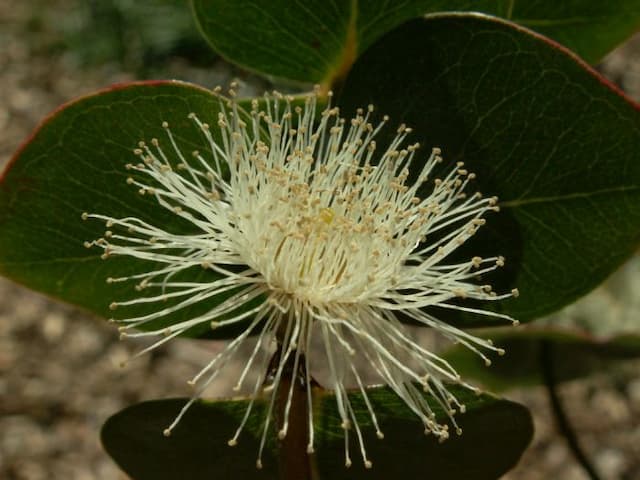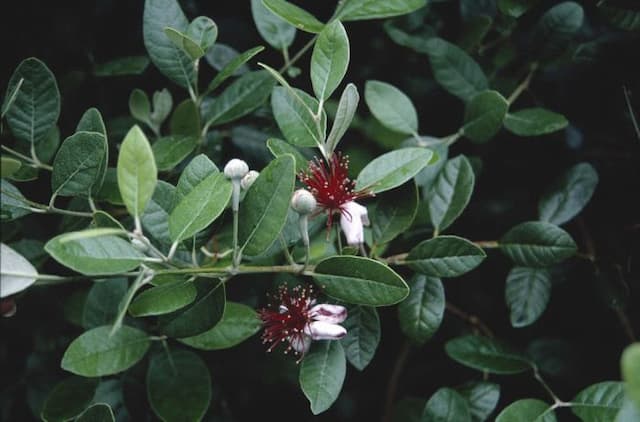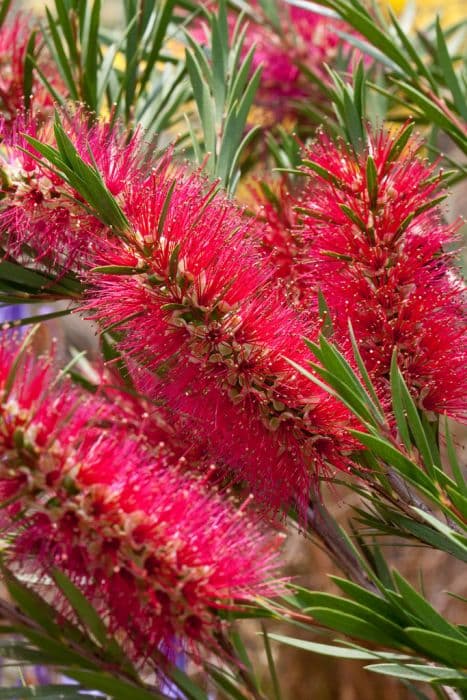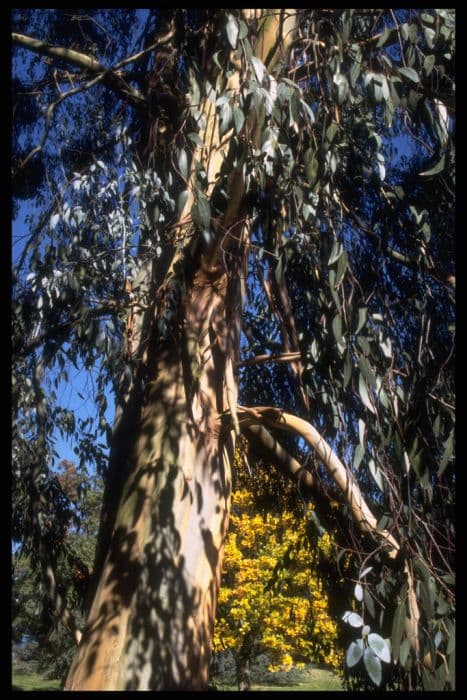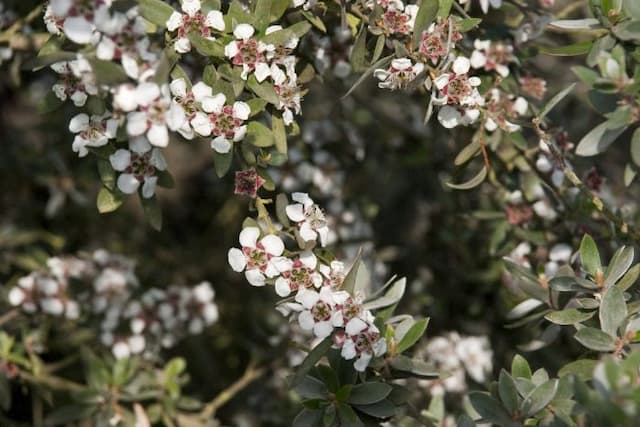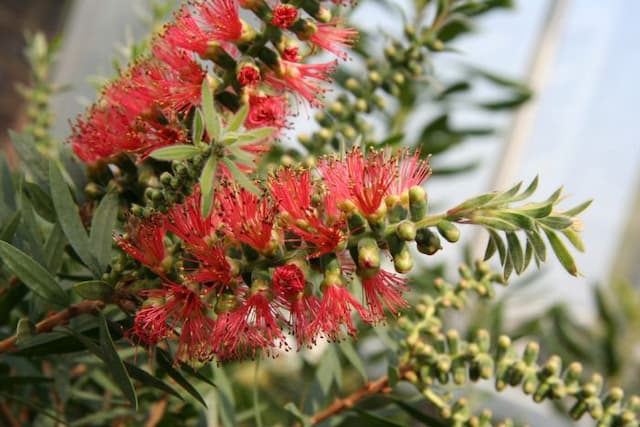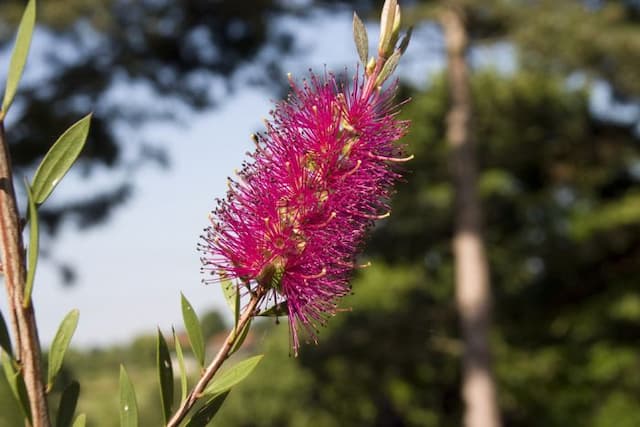Cider Gum Eucalyptus gunnii Azura = 'Cagire' (PBR)

ABOUT
Eucalyptus gunnii Azura, commonly known as Cider Gum, is a visually striking plant recognized for its distinctive foliage and smooth, peeling bark. The Cider Gum features rounded leaves with a silvery-blue hue, which not only add visual interest but also emit a refreshing menthol-like fragrance when crushed. The leaves are quite dense and can create a lush appearance. Younger foliage often appears in a more rounded shape, adding a soft texture to the plant's profile. As the Cider Gum matures, the leaves become more elongated and take on a sickle shape, offering an ever-evolving look throughout the plant's growth. The bark of the Cider Gum is another notable feature, showcasing a beautiful patchwork of greys, blues, and greens as it sheds in strips to reveal new layers beneath. Flowering can occur in the Cider Gum, producing clusters of small blooms that are generally white or cream-colored, although the flowers are not the most prominent characteristic of this plant. The visual contrast between the bark and the bright foliage can make the Cider Gum a stand-out addition to any garden, providing an exotic touch with its unique texture and color palette.
About this plant
 Names
NamesFamily
Myrtaceae
Synonyms
Cider Gum, Gunnii Azura, Eucalyptus 'Cagire'
Common names
Eucalyptus gunnii Azura.
 Toxicity
ToxicityTo humans
The Eucalyptus gunnii, commonly known as Cider Gum, contains compounds in its leaves and oil that can be toxic if ingested by humans. While the plant is mainly used for ornamental purposes and its oil has medicinal properties, ingestion can lead to symptoms such as gastrointestinal upset, nausea, vomiting, and diarrhea. Eucalyptus oil, in particular, is highly concentrated and can cause central nervous system depression and even be life-threatening in severe cases if consumed in substantial quantities. It is important to handle this plant with care and keep it out of reach of children who might be tempted to chew on the leaves.
To pets
Cider Gum is potentially toxic to pets if ingested. The plant's leaves contain eucalyptus oil, which can cause a range of symptoms including salivation, vomiting, diarrhea, depression, and weakness in pets like dogs and cats. In more severe cases, ingestion can lead to central nervous system depression and there have been reports of eucalyptol poisoning leading to more serious conditions such as seizures. Pet owners should ensure their animals do not chew on the leaves or bark of this plant and should seek veterinary attention immediately if they suspect their pet has ingested any part of it.
 Characteristics
CharacteristicsLife cycle
Perennials
Foliage type
Evergreen
Color of leaves
Blue-green
Flower color
Varies
Height
25 feet (7.62 meters)
Spread
10 feet (3.05 meters)
Plant type
Tree
Hardiness zones
8
Native area
Australia Tasmania
Benefits
 General Benefits
General Benefits- Ornamental Appeal: Eucalyptus 'Azura' has attractive silver-blue foliage that provides visual interest and contrast in gardens or landscapes.
- Drought Tolerance: Once established, it is relatively drought-resistant, making it a good choice for areas with low rainfall or water restrictions.
- Cold Hardy: It is relatively cold hardy compared to other eucalyptus species, able to withstand cooler temperatures.
- Fast Growing: This plant is known for its rapid growth rate, which makes it useful for quickly establishing a presence in a garden or landscape setting.
- Low Maintenance: Requires minimal care once established, with no need for regular pruning or fertilizing.
- Erosion Control: Its root system helps stabilize the soil, making it a good choice for slopes or areas prone to soil erosion.
- Wildlife Attraction: The flowers of the Eucalyptus 'Azura' can attract birds and bees, adding to the biodiversity of the garden space.
- Evergreen Nature: As an evergreen, it provides color and structure in the garden throughout the year, even in winter months.
 Medical Properties
Medical PropertiesThis plant is not used for medical purposes.
 Air-purifying Qualities
Air-purifying QualitiesThis plant is not specifically known for air purifying qualities.
 Other Uses
Other Uses- Eucalyptus gunnii Azura can be used as a natural dye for fabrics, providing a range of colors from soft yellows to green hues, depending on the mordant used.
- The wood from Eucalyptus gunnii Azura is quite dense and can be used in woodturning projects, making it popular for crafting small wooden items like bowls and pens.
- The leaves of the plant can be used for making decorative pressed leaf crafts, as they retain their shape and color well after drying.
- Dried leaves of Eucalyptus gunnii Azura can be incorporated into potpourris for a fresh and invigorating scent in the home.
- The plant's branches can be used as natural, sturdy stakes for supporting other plants in the garden.
- Eucalyptus gunnii Azura leaves can be infused in oil to create a fragrant eucalyptus oil that can be used in homemade candles and soaps.
- The rapid growth and dense foliage of Eucalyptus gunnii Azura make it useful for creating privacy screens or windbreaks in landscapes.
- Eucalyptus gunnii Azura can be mulched to create a eucalyptus mulch which may deter pests in the garden due to its scent.
- The flowers of the plant are a source of nectar and can attract pollinators such as bees and butterflies, contributing to the health of your garden's ecosystem.
- The wood of Eucalyptus gunnii Azura can be processed into chips for use in smoking meats, imparting a unique flavor.
Interesting Facts
 Feng Shui
Feng ShuiEucalyptus is not used in Feng Shui practice.
 Zodiac Sign Compitability
Zodiac Sign CompitabilityEucalyptus is not used in astrology practice.
 Plant Symbolism
Plant Symbolism- Healing: Eucalyptus is often associated with healing because of its medicinal properties, particularly its use in treating colds and respiratory issues.
- Protection: It is believed to have protective qualities, with some cultures using it to ward off evil spirits and negative energy.
- Cleansing: The plant is linked with cleansing, both in a physical sense, as it is used in antiseptics, and in a spiritual sense, believed to cleanse areas of bad spirits or energy.
- Refreshing: Its invigorating scent is seen as bringing a sense of renewal and vitality, symbolizing a refreshing of the mind and body.
- Abundance: Some cultures view eucalyptus as a symbol of abundance, possibly due to its fast growth and prolific nature.
 Water
WaterThe Cider Gum, as the Eucalyptus gunnii Azura is commonly known, requires consistent moisture but does not like to sit in waterlogged soil. In general, young trees should be watered once a week with about 2 gallons of water per session, adjusting for rainfall. Mature trees are more drought tolerant but will benefit from deep watering during prolonged dry spells, roughly every two to three weeks with up to 5 gallons per watering. The water should be applied directly to the root zone to encourage deep root growth. During winter months, when the tree is dormant, watering can be reduced significantly.
 Light
LightThe Cider Gum thrives in full sunlight, requiring at least six hours of direct sunlight daily. The ideal spot for this plant would be an area that is open and receives unfiltered sunlight for most of the day. Avoid locations that are shaded or partially shaded, as this would hamper the tree's growth and overall health.
 Temperature
TemperatureThe Cider Gum prefers a temperature range of 60 to 80 degrees Fahrenheit but can tolerate temperatures as low as 20 degrees Fahrenheit. It is important to protect young eucalyptus trees from frost, which can damage them. The ideal conditions for this plant would be in a location that experiences mild winters and does not face extreme temperature fluctuations.
 Pruning
PruningPruning the Cider Gum is necessary to maintain its shape and encourage healthy growth. It should be done in late winter or early spring before new growth begins. Prune dead or damaged branches, and trim back any overgrowth to maintain the desired shape. Young trees may be pruned to promote a single, strong trunk, while older trees generally require less frequent pruning. It's beneficial to prune every two to three years to keep the tree manageable and aesthetically pleasing.
 Cleaning
CleaningNot needed
 Soil
SoilThe best soil mix for a Cider Gum (Eucalyptus gunnii Azura) should be well-draining with a slightly acidic to neutral pH between 5.5 and 7.0. A mix of loam, sand, and compost is ideal to ensure good drainage and supply necessary nutrients.
 Repotting
RepottingCider Gum trees, being fast growers, may need repotting every 1 to 2 years, especially when young and if they are being grown in containers. As they mature, repotting frequency can decrease.
 Humidity & Misting
Humidity & MistingCider Gum trees prefer moderate to low humidity levels, typical to their native Tasmanian climate, and can tolerate dry air very well.
 Suitable locations
Suitable locationsIndoor
Place in bright, indirect light and ensure proper air circulation.
Outdoor
Plant in full sun, shelter from extreme winds.
Hardiness zone
7-10 USDA
 Life cycle
Life cycleThe life cycle of Eucalyptus gunnii Azura, commonly known as 'Cider Gum', begins with seed germination, which requires exposure to light and may be helped by stratification to overcome dormancy. After germination, the seedling stage involves the development of the root system and first true leaves, which is critical for the plant's survival. As it matures into a juvenile tree, the iconic blue-green, rounded juvenile foliation develops which later transitions into lance-shaped, adult foliage as it evolves. Once mature, typically after several years, Cider Gum produces small white flowers which are followed by the development of woody, cup-shaped fruit containing numerous seeds. After reaching full maturity and peak reproductive output, the tree may live for several decades, continuing a cycle of flowering and seed production annually. Finally, when the plant reaches the end of its life, it will die back and decompose, contributing to the nutrient cycle within the ecosystem.
 Propogation
PropogationPropogation time
Spring-Early Summer
The Eucalyptus gunnii 'Azura', commonly known as the Cider Gum, is generally propagated using seed or semi-hardwood cuttings. The most popular method for propagating this particular cultivar is by semi-hardwood cuttings, which is typically carried out in the late summer. To propagate by cuttings, one should select healthy, semi-hardwood stems from the current year's growth and cut them into lengths of about 4 to 6 inches (approximately 10 to 15 centimeters). The leaves on the lower half of the cutting should be removed, and the cut end may be dipped into a rooting hormone to encourage root development. These cuttings should then be placed in a well-draining growing medium and kept moist and warm until roots have developed, which can usually take several weeks. It is important to maintain high humidity around the cuttings, often done by placing a plastic cover over the propagation area.
